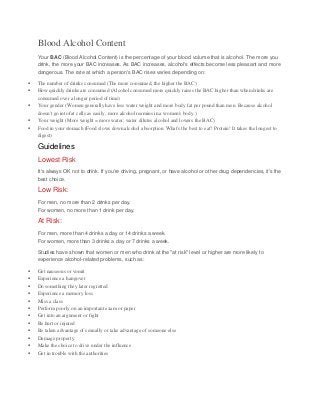
Blood alcohol content midterms
- 1. Blood Alcohol Content Your BAC (Blood Alcohol Content) is the percentage of your blood volume that is alcohol. The more you drink, the more your BAC increases. As BAC increases, alcohol's effects become less pleasant and more dangerous. The rate at which a person's BAC rises varies depending on: The number of drinks consumed (The more consumed, the higher the BAC) How quickly drinks are consumed (Alcohol consumed more quickly raises the BAC higher than when drinks are consumed over a longer period of time) Your gender (Women generally have less water weight and more body fat per pound than men. Because alcohol doesn't go into fat cells as easily, more alcohol reamins in a women's body.) Your weight (More weight = more water; water dilutes alcohol and lowers the BAC) Food in your stomach (Food slows down alcohol absorption. What's the best to eat? Protein! It takes the longest to digest) Guidelines Lowest Risk It's always OK not to drink. If you're driving, pregnant, or have alcohol or other drug dependencies, it's the best choice. Low Risk: For men, no more than 2 drinks per day. For women, no more than 1 drink per day. At Risk: For men, more than 4 drinks a day or 14 drinks a week. For women, more than 3 drinks a day or 7 drinks a week. Studies have shown that women or men who drink at the "at risk" level or higher are more likely to experience alcohol-related problems, such as: Get nauseous or vomit Experience a hangover Do something they later regretted Experience a memory loss Miss a class Perform poorly on an important exam or paper Get into an argument or fight Be hurt or injured Be taken advantage of sexually or take advantage of someone else Damage property Make the choice to drive under the influence Get in trouble with the authorities
- 2. If one thinks in terms of blood alcohol concentration (BAC), it's really not surprising that women and men who stick to the low-risk drinking guidelines experience fewer negative alcohol-related consequences than their peers who drink more. "A Drink" is: 12 ounces of beer, or 5 ounces of wine, or 1.5 ounces of hard liquor Blood Alcohol Content Possible Effects .02% to .04% Lightheaded - Mildly relaxed, mood may be mildly intensified .05% to .07% Buzzed - Feel warm and relaxed, good moods are better and bad moods are worse, euphoria, may talk louder/act bolder than usual .08% to .10% Legally Impaired - May slur speech, balance/motor skills become impaired, sight/hearing ability clearly diminished, judgement/self-control impaired, may take poor/risky sexual choices. .11% to .15% Drunk - "High," balance very impaired, judgement, memory and motor skills impaired, may forget how many drinks you have had past this point, men may have trouble functioning sexually. .16% to .19% Very Drunk - Euphoria may give way to unpleasant feelings (depression), difficulty talking/walking/standing, sharp increase in chances of physically injuring yourself or others, may experience a blackout at this level or higher, nausea, dizzy, blurred vision. .20% Confusion and Disorientation - May need help to stand or walk; if you hurt yourself, you probably won't realize it because the alcohol has numbed your pain and your judgement is so impaired you might not do anything about it; nausea and vomiting common, getting very dangerous because gag reflex is impaired, so you could choke if you do throw up (especially if you black out). .30% Stupor - Likely to pass out involuntarily (as opposed to lower BAC's where you may decide to stop drinking and go to sleep); if pass out, may be difficult for others to wake you; possible to die from alcohol poisoning or choking on vomit at this level and higher .35% Equivalent to general anesthesia, breathing may stop. .40% Coma likely, breathing and heartbeat slowed to dangerous levels due to slowdown in nerve activity
